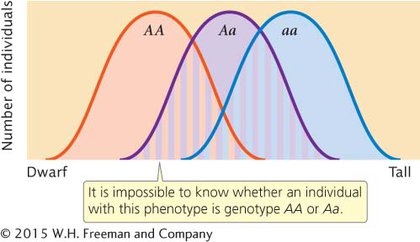The Relation Between Genotype and Phenotype
For some discontinuous characteristics, the relation between genotype and phenotype is straightforward: each genotype produces a single phenotype, and most phenotypes are encoded by a single genotype. Dominance and epistasis may allow two or three different genotypes to produce the same phenotype, but the relation remains simple. This simple relation between genotype and phenotype allowed Mendel to decipher the basic rules of inheritance from his crosses with pea plants; it also permits us to predict the outcome of genetic crosses and to assign genotypes to individuals.
For quantitative characteristics, the relation between genotype and phenotype is usually more complex. If the characteristic is polygenic, many different genotypes are possible, several of which may produce the same phenotype. For instance, consider a plant whose height is determined by three loci (A, B, and C), each of which has two alleles. Assume that one allele at each locus (A+, B+, and C+) encodes a plant hormone that causes the plant to grow 1 cm above its baseline height of 10 cm. The other allele at each locus (A−, B−, and C−) does not encode a plant hormone and thus does not contribute to additional height. If we consider only the two alleles at a single locus, 3 genotypes are possible (A+A+, A+A−, and A−A−). If all three loci are taken into account, there are a total of 33 = 27 possible multilocus genotypes (A+A+ B+B+ C+C+, A+A− B+B+ C+C+, etc.). Although there are 27 genotypes, they produce only seven phenotypes (10 cm, 11 cm, 12 cm, 13 cm, 14 cm, 15 cm, and 16 cm in height) because some of the genotypes produce the same phenotype (Table 17.1). For example, genotypes A+A− B−B− C−C−, A−A− B+B− C−C−, and A−A− B−B− C+C−each have one gene that encodes a plant hormone. Each of these genotypes produces one dose of the hormone and results in a plant that is 11 cm tall. Even in this simple example with only three loci, the relation between genotype and phenotype is quite complex. The more loci encoding a characteristic, the greater the complexity. As the number of loci encoding a characteristic increases, the number of potential phenotypes increases, and differences between individual phenotypes become more difficult to distinguish.
| Plant genotype | Doses of hormone | Height (cm) |
|---|---|---|
| A−A− B−B− C−C− | 0 | 10 |
A+A− B−B− C−C− A−A− B+B− C−C− A−A− B−B− C−C+ |
1 | 11 |
A+A+ B−B− C−C− A−A− B+B+ C−C− A−A− B−B− C+C+ A+A− B+B− C−C− A+A− B−B− C+C− A−A− B+B− C+C− |
2 | 12 |
A+A+ B+B− C−C− A+A+ B−B− C+C− A+A− B+B+ C−C− A−A− B+B+ C+C− A+A− B−B− C+C+ A−A− B+B− C+C+ A+A− B+B− C+C− |
3 | 13 |
A+A+ B+B+ C−C− A+A+ B+B− C+C− A+A− B+B+ C+C− A+A+ B−B− C+C+ A+A− B+B− C+C+ A−A− B+B+ C+C+ |
4 | 14 |
A+A+ B+B+ C+C− A+A− B+B+ C+C+ A+A+ B+B− C+C+ |
5 | 15 |
| A+A+ B+B+ C+C+ | 6 | 16 |
|
Note: Each + allele contributes 1 cm in height above a baseline of 10 cm. |
||
The influence of environment on a characteristic can also complicate the relation between genotype and phenotype. Because of environmental effects, the same genotype can produce a range of potential phenotypes. Furthermore, the phenotypic ranges of different genotypes can overlap, making it difficult to know whether individuals differ in phenotype because of genetic or environmental differences (Figure 17.2).

In summary, the simple relation between genotype and phenotype that exists for many qualitative (discontinuous) characteristics is absent in quantitative characteristics, and it is impossible to assign a genotype to an individual on the basis of its phenotype alone. The methods used for analyzing qualitative characteristics (examining the phenotypic ratios of progeny from a genetic cross) will not work with quantitative characteristics. Our goal remains the same: we wish to make predictions about the phenotypes of offspring produced in a genetic cross. We may also want to know how much of the variation in a characteristic results from genetic differences and how much results from environmental differences. To answer these questions, we must turn to statistical methods that allow us to make predictions about the inheritance of phenotypes in the absence of information about the underlying genotypes.  TRY PROBLEM 11
TRY PROBLEM 11